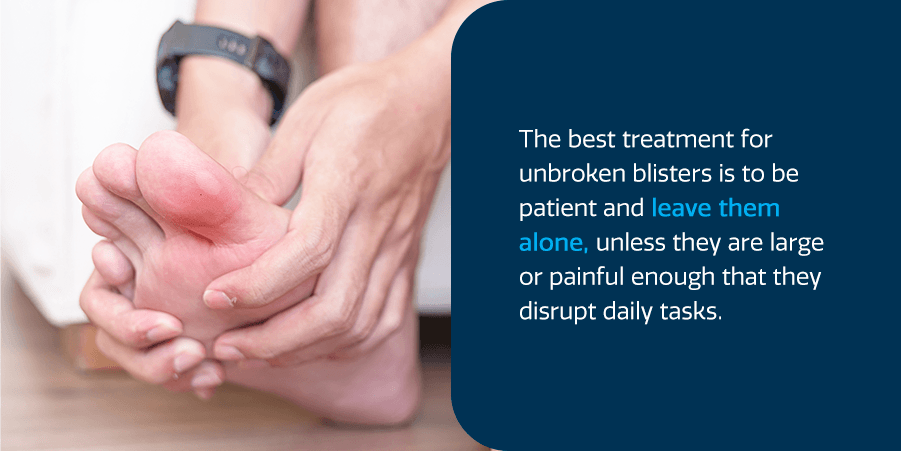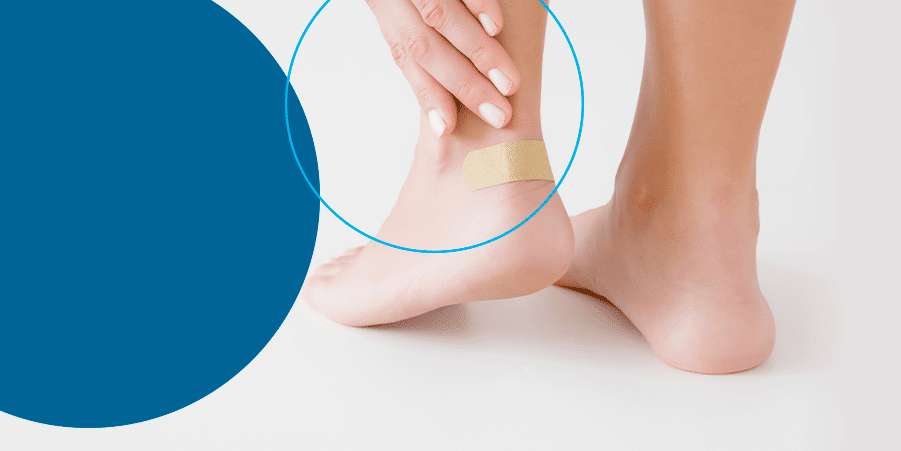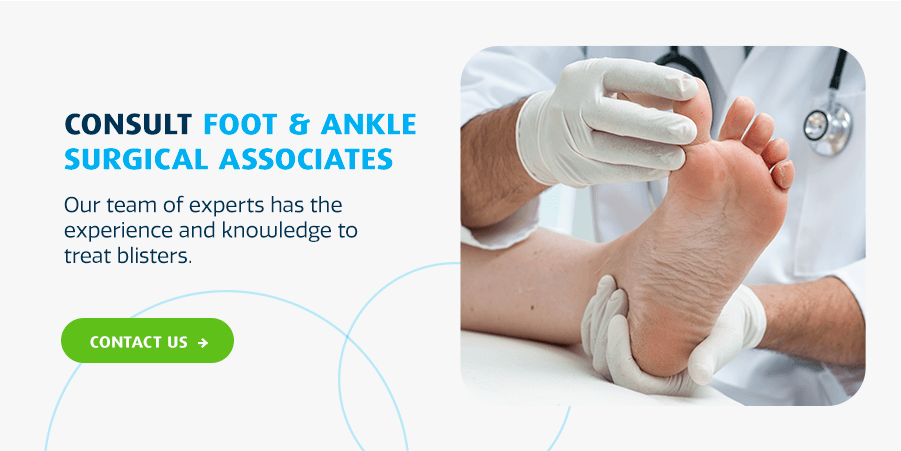Blisters that develop on the feet can be painful and uncomfortable. They’re often caused by excessive friction in one area of the skin, such as when your ankle rubs against the back of shoes that are too small. Blisters can also form from burns or allergic reactions from insect stings or bites.
When caring for foot blisters, leaving them alone is crucial, as they often drain on their own as the raw skin heals. If you have a foot blister that becomes discolored or doesn’t heal, speaking to a podiatrist can be helpful, as they can prescribe medication if necessary. There are also numerous ways to prevent or care for blisters at home.
What Are Blisters?
Blisters are skin lesions that form on the skin. They are the body’s natural defense mechanism to protect damaged skin. Your skin consists of three layers — the epidermis, dermis and subcutaneous fat, which is below the skin. Blisters form beneath the epidermis as a fluid-filled sac. As the outer layer of skin disintegrates, a small pocket of fluid forms on the raw skin to create a blister.
Depending on the injury, they can cause pain and are often filled with clear liquid, appearing in a cluster or as a single bubble. Blisters usually appear on the feet near the soles and on the palms of your hands, though they can appear anywhere on the body. For instance, blisters can form in places where sports equipment or clothes rubs against the skin. Friction combined with warm, moist environments is conducive to blisters.
While stings, burns and small shoes can cause foot blisters, some existing conditions can also cause them, such as eczema and contact dermatitis. Blisters can be very painful or itchy. If a blister becomes infected, it will fill with pus. In these cases, seeking medical attention is crucial to prevent further complications.
How to Prevent Foot Blisters
To prevent chafing that can lead to foot blisters, try the following tips:
- Protect your feet: Wear moisture-wicking socks like nylon to prevent foot blisters. Sweat and moisture in the shoes can create the perfect environment for blisters to form. You can also try wearing two pairs of socks to protect your skin from rubbing against your shoes.
- Consider soft bandages: For problem areas, like the feet and thighs, you might use soft bandages like adhesive moleskin to protect your feet. Securely apply the bandages to ensure they are effective.
- Apply powder to problem areas: Powder and petroleum jelly can help reduce friction when your skin rubs together or against clothing.
- Wear properly-fitting shoes: Ensure your shoes fit properly to prevent blisters. When purchasing new shoes, have your feet measured by professionals to ensure the right size. They shouldn’t be too tight or loose, as improperly fitting shoes can lead to excessive friction as you walk.
- Stop your activity if you notice pain: If you notice any pain, redness or discomfort, stop your activity immediately or you could get a blister.

How to Care for Foot Blisters
When caring for blisters, including toe blister care, you should prioritize keeping them from worsening and avoiding infection. The best treatment for unbroken blisters is to be patient and leave them alone, unless they are large or painful enough that they disrupt daily tasks. You should also avoid resuming the activity that caused the blister until it is healed. While they can be very painful and uncomfortable, it’s crucial that you let your blister heal on its own, which can take one to two weeks.
To care for a blister and understand how to deal with blisters on your feet, try the following methods:
- Cover the blister: If you have a blister, loosely cover it with a bandage, raising the sides of it so that the middle of the bandage is slightly raised.
- Use padding: To protect foot blisters in those pressure areas, like the bottom of your feet, use a little cushioning. Cut the padding so that the hole is around the blister. Then, cover the blister and padding with a bandage.
- Avoid popping or applying pressure: Do not pop or drain your blister, which can lead to infection. However, if the blister is large and painful or in an awkward spot, it may be necessary to drain it with professional help. Podiatrists and other medical professionals can drain blisters in the safest, most sterile way possible.
- Wear loose-fitting clothing: To avoid irritating your blister, wear loose-fitting clothing like loose socks or sandals that won’t rub against it.
- Use soap and water: If your blister is drained, it’s crucial that you wash the area with soap and water. You might also apply petroleum jelly, which can help your skin heal by easing inflammation and keeping your skin moist. Moisture can also prevent itchiness and scratching, which can lead to infection.
Don’t attempt to drain or treat big and painful blisters without consulting a physician or a specialist. Improperly draining a blister can cause skin or tissue damage or an infection. Do not use alcohol, iodine or hydrogen peroxide on a drained blister. Also, be sure not to remove the top of the blister, as it will help protect the raw skin underneath it as it heals. Use an antibiotic ointment or petroleum jelly and cover the area loosely with gauze or a sterile bandage after caring for your foot blister.
Popped or drained blisters often take longer to heal, especially if the top layer of skin is missing.
When to See a Doctor
While most blisters will heal on their own in a few weeks, watch for signs of infection. Call your doctor or a board-certified dermatologist if you notice pus, redness or increased swelling and pain.
An infected or extremely painful blister can be concerning. Signs of infection include:
- A swollen or inflamed area
- The presence of pus
- Red, warmed skin around the blister
- Worsening pain
- Yellowish crusting on the area
- Red streaks near or coming from the blister
- Tenderness in the area
Additionally, you should see a doctor if you experience fever, chills or other flu-like symptoms while dealing with a foot blister. This could be a sign of an infection or virus.
Consult Foot & Ankle Surgical Associates
Blisters can be incredibly painful and uncomfortable, especially on the feet. However, with proper care, they should heal on their own. If you experience worsening pain, swelling or other signs of infection, it’s crucial that you seek medical assistance. For any foot or ankle problems, consult with the certified podiatrists at Foot & Ankle Surgical Associates.
Our team of experts has the experience and knowledge to treat blisters and other foot ailments with evidence-based treatments for various conditions and injuries. To schedule an appointment, call us at 360-754-3338 or fill out a form today.






